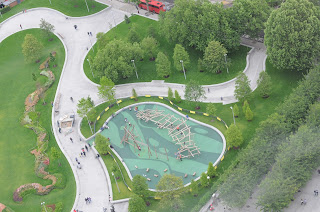The 'green and pleasant land' of William Blake's poem describes an England 200 years ago, before industrialisation transformed a predominantly rural, agricultural economy into the urbanised, global marketplace of today. With over 53 million people and a population density of almost 400 per sq km, much of the landscape, especially in towns and cities, is no longer green. And the seismic social and economic upheavals of the last two centuries have resulted in aspects of contemporary society that are not particularly pleasant.

Almost everything you read about British wildlife confirms that it's in trouble. Changing weather patterns, habitat destruction, persecution of native mammals, introduction of exotic species, air pollution and contamination of the waterways have all disrupted the ecological balance and contributed to the decline in bees, frogs, newts and many bird species. During a three week visit to my home country, however, I found wonderful and inspiring things that gave me reason to hope for the future.
Important work is being done all around the country to preserve and restore habitats for wildlife. The once biologically dead River Thames is now one of the cleanest metropolitan waterways in the world, home to around 120 species of fish and, with them, waterbirds. At Canary Wharf, for example, we saw a family of Great Crested Grebes, a species that was once hunted almost to extinction for its elaborate head plumage.

At Brockholes, in Lancashire, a disused sand and gravel quarry is being transformed into wetlands that will provide an important sanctuary for resident and migratory birds. One of the priorities is to recreate some of the area's old landscapes, in particular reedbeds. The hope is that these will provide habitat for spectacular - but threatened - plants and animals, including marsh orchids, Reed and Sedge Warblers, Bittern, Bearded Tits, Marsh Harriers and Water Voles.

I spent my childhood and adolescence in Preston, in North West England, where the decline of the textile industry from the mid-20th century brought hardship and the dilapidation of housing and commercial buildings. As the city struggled to reassert itself in the post-industrial era, large areas of rural land were used to replace the high density Victorian terraced housing and crumbling concrete housing blocks that once dominated the city centre. The good news is that with sensitive city planning, involving preservation of ancient woodlands and extensive tree planting, wildlife continues to thrive, even in this most urban of environments.

Adjacent to our family home, for example, there's an ecologically significant ancient woodland, that's now protected as a Biological Heritage Site. In the past, much of England was covered with these 'wildwoods' which, according to legend, provided refuge for Robin Hood and his band of merry outlaws. With urbanisation and population growth, however, they now only account for around 1.5% of the country's land surface.

Because of their long, continuous history, ancient woodlands support many native plants and animals, some of which are only found in these habitats. I went walking in the woods many times during my visit and was struck by the variety of mature trees - oak, sycamore, beech, wych elm, ash, wild cherry and lime - that provide a dense, complex canopy for the understorey and groundcover species. On the dark, damp forest floor, it feels like you're in the rainforest. And there were so many birds - nuthatches, robins, woodpeckers, blue-tits, jays, blackbirds - busily occupied in the race to give their families the stamina to survive the bitterly cold, hard winter months.
In response to a challenge by the Independent Panel on Forestry, the UK Government recently asserted that: "Protection of our trees, woods and forests, especially our ancient woodland, is our top priority." Considering how rare and precious these forests are, and their ecological importance, let's hope the Government fulfils its promise.














